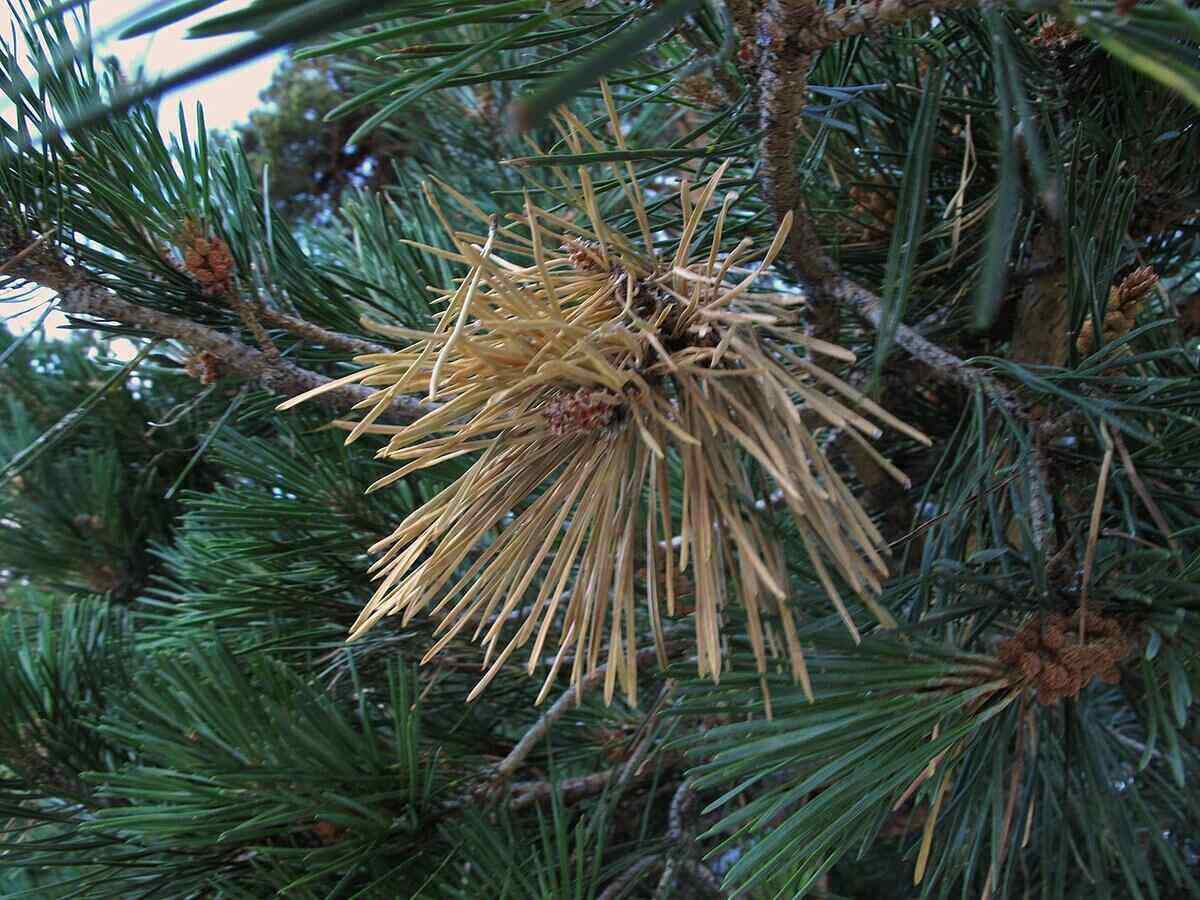
Noticeable needle loss or discoloration in pine trees could be a sign of a diseased tree. But what disease, and how can you treat your pine tree to restore it to health? So, if you’re asking yourself why your pine trees are turning brown, in this article, we’ll detail 10 common pine tree diseases and how to treat them.
We also have included a tree care expert’s comments on how to get your pine tree looking green again. After all, pines are evergreen trees, which means a healthy pine should stay green all year long.
Pine Tree Diseases and How to Treat Them
First, it is essential to identify the fungal disease invading your pine tree. The last thing homeowners want is a disease spreading to their healthy trees. Infection can spread through the soil, air, rain, and even contaminated pruning tools.
If you think your tree may have a fungal disease, we’ll give you identification tips and explain how to treat a pine tree that’s turning brown.
Note: Some infections are more severe than others and affect different pine tree types. Keep in mind that a professional arborist should make any diagnosis.
If you want expert advice, jump to the expert comments of Dr. Curtis L. VanderSchaaf, Forestry Regional Extension Specialist at Mississippi State University Extension.
1. Annosus Root Rot
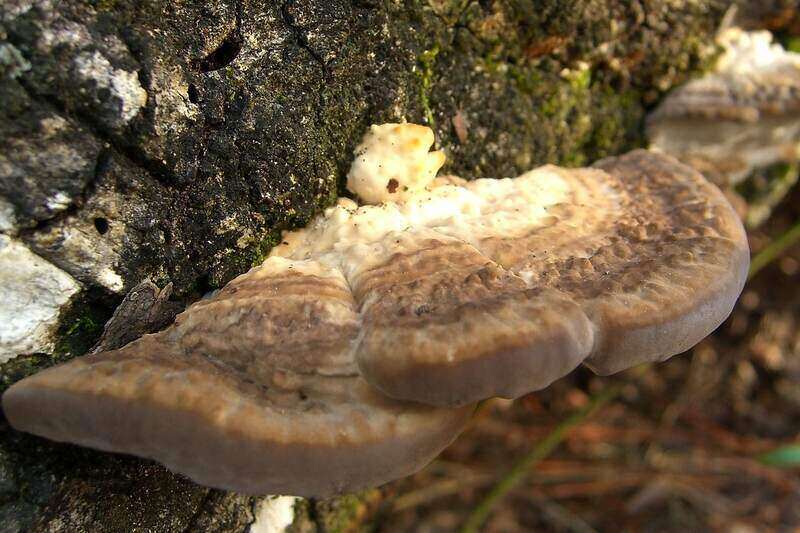
Photo Credit: Jason Hollinger / Flickr / CC BY 2.0
Annosus root rot stunts needle growth and causes a decaying condition called butt rot. This fungal disease is a concern in pine plantations where thinning has occurred. The freshly cut stumps following thinning encourage the spread of this disease. Although this disease leads to death, there is a solution to prevent it from spreading to healthy pines.
Pine trees affected: This disease affects these pine trees the most:
- Loblolly
- Slash pines
- White pines
Annosus root rot occasionally infects these pines:
- Shortleaf
- Longleaf
- Ponderosa
- Western white
- Lodgepole
- Whitebark
- Jack
- Pond
- Red
- Pitch
- Sand
- Virginia
Symptoms: Substantial stump decay will occur. The roots and butt develop a soft, stringy, white rot. The fungus may generate conks or fruiting bodies at the base of the trunk. These fruiting bodies vary in shape and are between gray-brown and dark-brown in color on their surface and white underneath.
Causes: The fungus, Heterobasidion annosum, spreads the most when stumps are freshly cut. Wind or splashing rain can carry the fungus from infected stumps to healthy trees with cut surfaces. After landing, the spores then penetrate the wood to establish an infection.
Infections can remain latent for decades before resuming growth in the pine tree. Stumps and trees with annosus root rot can also infect healthy trees through their roots.
Treatment: Common borax powder applied to the surfaces of freshly cut stumps will help prevent the spread to neighboring trees. Apply the borax powder in a salt shaker manner.
Seasons: Harvesting pines during dry summer and fall months lowers the possibility for spread.
Risk level: This disease is most concerning in forests following thinning, an operation that removes rows of trees. Trees of all ages can die from this disease, and volume losses from butt rot will occur in some species. In pines, death occurs after extensive decay.
2. Brown Spot Needle Blight
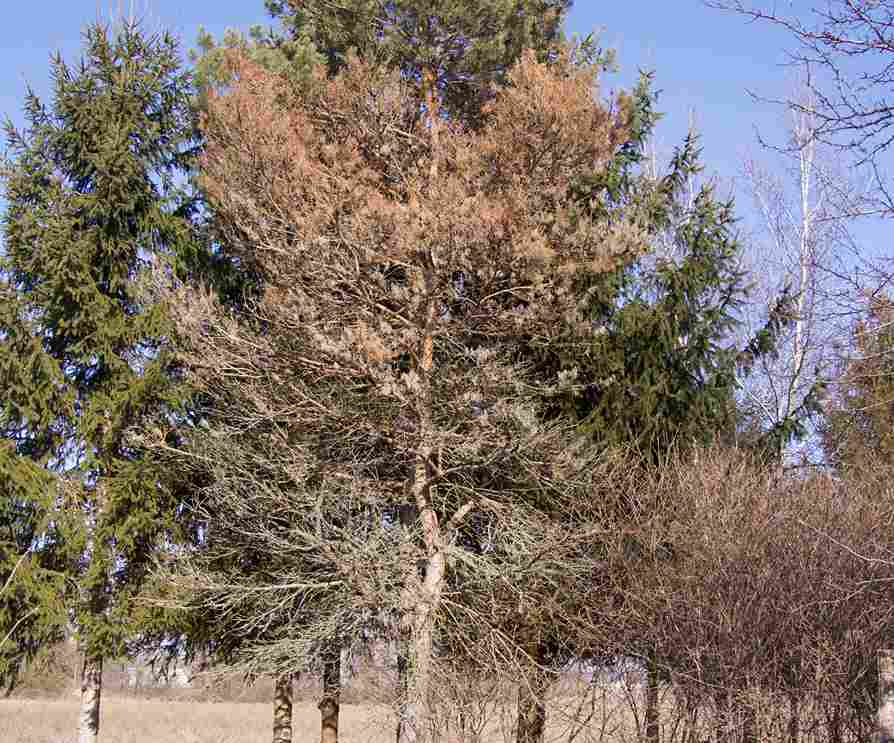
Photo Credit: F. D. Richards / Flickr / CC BY-SA 2.0
Brown spot needle blight is a pine tree disease that causes a large problem for longleaf pine seedlings and Afghan pines grown in Christmas tree nurseries. Symptoms occur months after infestation and can spread rapidly in permitting weather conditions.
Pine trees affected:
- Longleaf
- Afghan
- Mugo
- Japanese black
- Virginia
- Eastern white
- Red
- Austrian
- Scots
Symptoms: Circular gray-green spots appear on the pine needles in the fall. The spots then enlarge and form narrow brown bands encircling the needles. The needles then die and fall off.
Causes: Brown spot needle blight is caused by the fungus Lecanosticta acicola (formerly Mycosphaerella dearnessii). It spreads only in wet weather. The splashing of rainwater enables the spores to spread rapidly and infect large areas of the tree. Contaminated pruning tools can also spread this disease.
This fungus, along with other pathogens, is also associated with white pine needle disease (WPND).
Treatment: Prescribed and managed fire burning every two or three years eliminates the infected needles and kills the infectious spores. Professional fungicide sprays can also control the fungus.
The Michigan State University Extension recommends applying fungicide when new needles are about half-grown between May and June and applying a second spray three weeks later.
Seasons: Symptoms appear in the early fall. The fungus spreads during warm, wet summer months.
Risk level: Nursery seedlings are most susceptible to infection when in the grass stage and will often die from brown spot needle blight. The disease can kill young pine trees that have been infected year after year.
3. Cotton Root Rot
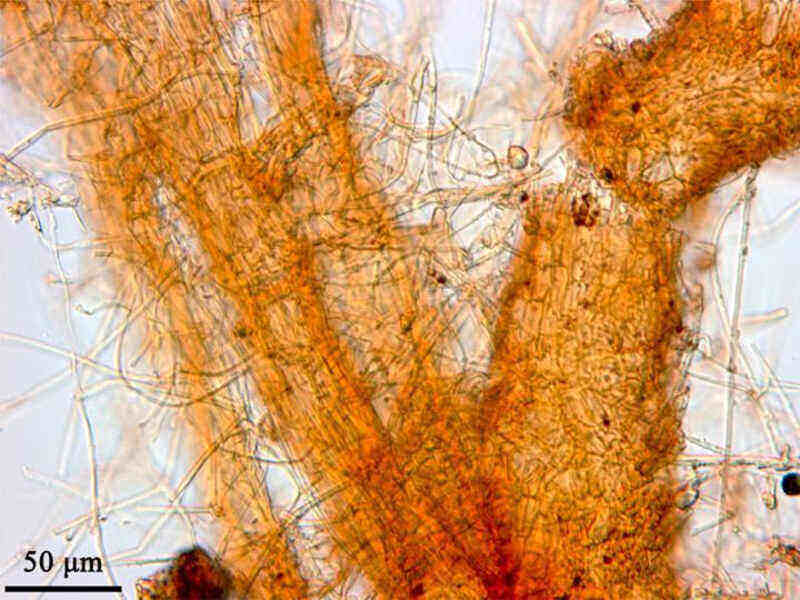
Photo Credit: Dr Jose R. Liberato / Wikimedia Commons / CC BY 3.0 AU
Cotton root rot is also known as Phymatotrichum root rot, Texas root rot, and Ozonium root rot. The fungal disease infects more than 2,000 species of plants and is one of the most challenging fungal diseases to control. Cotton root rot is most prominent in the Southwestern United States.
Pine trees affected: Pines exposed to high temperatures and alkaline soils or soils of limestone origin are most susceptible, such as Afghan pine.
Symptoms: Symptoms begin with a slight yellowing or bronzing of the host’s leaves. After three days, permanent wilting occurs, followed by death. Trees and shrubs will succumb to the disease more slowly. Affected areas appear as circular patterns of dead plants and can gradually enlarge over time.
Causes: Cotton root rot is caused by the fungus Phymatotrichum omnivorum. The fungus invades new areas by slow growth through the soil from plant to plant. The fungus can survive in the soil for many years and as far as 8 feet deep in the ground.
Treatment: If cotton root rot is infecting your pine, there is a chance of saving the tree if the decay is not yet substantial. The Oklahoma State University Extension recommends this process:
- Cover a ridge of soil around the tree’s drip line with a 2-inch layer of organic matter or cow manure.
- Scatter ammonium sulfate and sulfur over the manure.
- Flood the basin with enough water to soak the soil to a depth of 3 feet.
- Keep the soil moist for several weeks.
- The tree is likely to recover within the season.
Another solution is to plant a resistant grass crop around the infected area. The resistant crop creates a barrier that limits the spread of the disease.
Seasons: Symptoms usually occur from June through September when soil temperatures reach 82 degrees Fahrenheit.
Risk level: This fungal disease can survive in the soil for many years and kill even your tallest pine trees.
4. Damping-Off
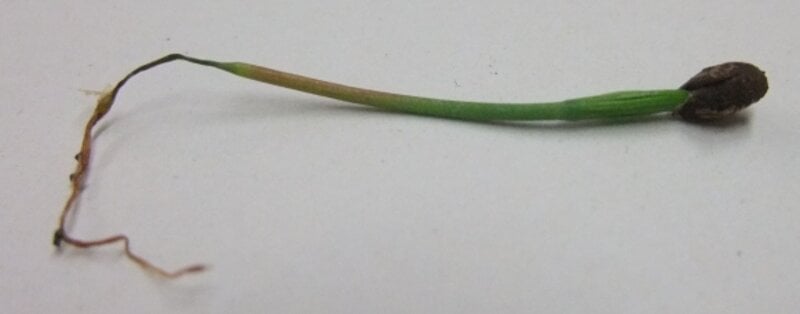
Photo Credit: INAKAVillage211 / Wikimedia Commons / CC by SA 3.0
Damping-off is caused by a variety of pathogenic fungi, including Pythium sp., Rhizoctonia sp., Sclerotium sp., Fusarium sp., and Cylindrocladium sp. Proper prevention methods are the only way to save your pine seedlings from this disease. These pathogenic fungi usually live on dead organic matter in the soil.
Pine trees affected: Damping-off affects many plant seedlings. Most types of pine tree seedlings are susceptible to this disease.
Symptoms: Seedlings failing to emerge from the soil is a symptom of damping-off. If emerged, the lower stems of the seedling will collapse, and the seedling limps over. Seedling stems may appear water-soaked, soft, mushy, and discolored. Roots may appear absent or stunted.
Causes: These pathogenic fungi can attack young seedlings above, below, or at the soil line. The disease is most active in wet, moist soils. Pine seedlings are susceptible to the disease for a short period and will outgrow their vulnerability.
- Wind, insects, and water can all carry the infectious spores to the soil.
- Dirty hands, contaminated tools, or hose ends can add pathogenic fungi.
- Once introduced, the pathogens move from plant to plant.
- Low light, overwatering, and over-fertilization can add to the damping-off.
Treatment: Prevention is the best way to control damping-off in plant seedlings:
- Buy pine seedlings from nurseries with light, sandy soils that are less susceptible to pathogen growth.
- Raise the seedbeds so that they drain after irrigation and don’t remain too moist.
- Mulch the seedbeds with pine needles.
- Fumigate the soil with an approved soil fumigant before planting.
- Treat the seeds with a seed-protectant fungicide.
Seasons: Soil temperatures for damping-off vary depending on the pathogenic fungus.
Risk level: Damping-off is a common and fatal disease that affects all types of plant seedlings.
5. Diplodia (Sphaeropsis) Tip Blight
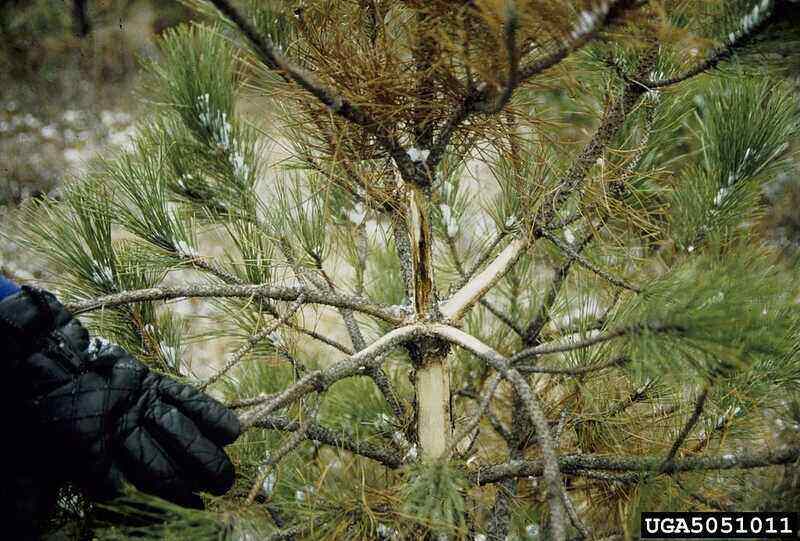
Photo Credit: Joseph O’Brien / Wikimedia Commons / CC BY 3.0 US
Formerly Sphaeropsis blight (fungus – Sphaeropis sapinea), Diplodia tip blight (fungus — Diplodia pinea) attacks stressed ornamental trees in a garden or yard. Trees that are weakened by excessive shade, drought, compacted soils, insect feeding, or other adverse conditions are commonly affected. Diplodia tip blight is rarely seen in forest settings.
Pine trees affected: This disease attacks two-or-three-needled pines such as:
- Austrian
- Mugo
- Ponderosa
- Red
- Scotch
Symptoms:
- Needles begin to brown, yellow, or gray at the tip.
- Needles will appear short and stunted.
- Small, black pycnidia (fruiting bodies) develop on needles, cones, or shoots.
- Cankers on stems and branches may develop.
- Oozing resin may develop.
Causes: The fungus overwinters in infected needles, cones, and tissue. Then:
- From March through September, during wet conditions, the pycnidia release brown spores.
- Wind, water, and animals spread to healthy trees.
- The fungus germinates on the needles and quickly kills the tissue.
- The fungus may enter the needles or the tree through wounds caused by feeding insects, weather, or even pruning.
- In the second year, cones become infected and subsequently spread the disease.
Treatment:
- Prune infected twigs, branches, and cones during dry weather.
- Disinfect tools frequently as you are pruning.
- Remove and burn or bury the contaminated materials.
- Apply fungicides in early spring.
- Avoid excessive fertilization.
- Keep trees watered during drought, but avoid watering from above.
- Mow around the trees to remove weeds and allow for air to circulate.
Seasons: Diplodia tip blight is present year-round. The fruiting bodies appear in summer.
Risk level: If a canker infection becomes severe, it may kill wood tissue and significant parts of the tree. This disease causes the most considerable damage to trees more than 30 years old. Rarely attacks trees under 15 years old but can be harmful to young seedlings.
6. Dothistroma Needle Blight
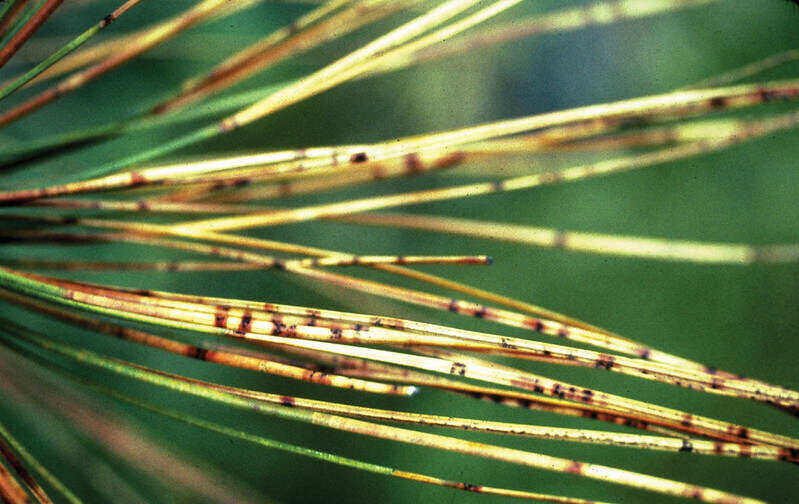
Photo Credit: U.S. Department of Agriculture / Flickr / CC BY 2.0
Another pine tree blight, Dothistroma needle blight, also called red-band needle blight, leads to excessive defoliation. Trees don’t die directly from it, but they become vulnerable to blight and attack by creatures such as bark beetles.
Pine trees affected: This common mugo pine disease (see picture) causes the most damage to Austrian pine and Ponderosa pine. Red and Scotch pines are also susceptible. Trees near rivers, especially ones in canyons that produce long periods of humidity, are vulnerable.
Symptoms: Needles over 20 feet high are rarely affected, but as for the rest of them:
- Between March and April, the needles on the lower part of the tree begin to turn brown.
- The needles turn brown at the tip while the base of the needles remains green.
- A reddish-brown band appears to form around the needles’ remaining green.
- Black fruiting bodies, stromata, can be seen in the bands of the needles.
Causes: The fungus Mycosphaerella pini causes Dothistroma needle blight. The stromata rupture through the epidermis of infected needles and release infectious spores. The spores are then spread by the wind or rain and infect healthy needles throughout the growing season.
Treatment: The University of Minnesota Extension recommends applying copper fungicides once before buds open in the spring and again when needles have grown to their full length in the summer. Several years of treatment may be needed. Pruning infected branches and moving sprinklers away from pine needles also reduce the spread.
Seasons: New infections typically appear in late summer and fall.
Risk level: This fungal disease kills needles of all ages and can weaken or eventually kill your pine trees. It is a slow-moving disease that takes a full year to complete its life cycle. It often takes years of repeated infection to develop a severe problem for your tree.
7. Fusiform Rust
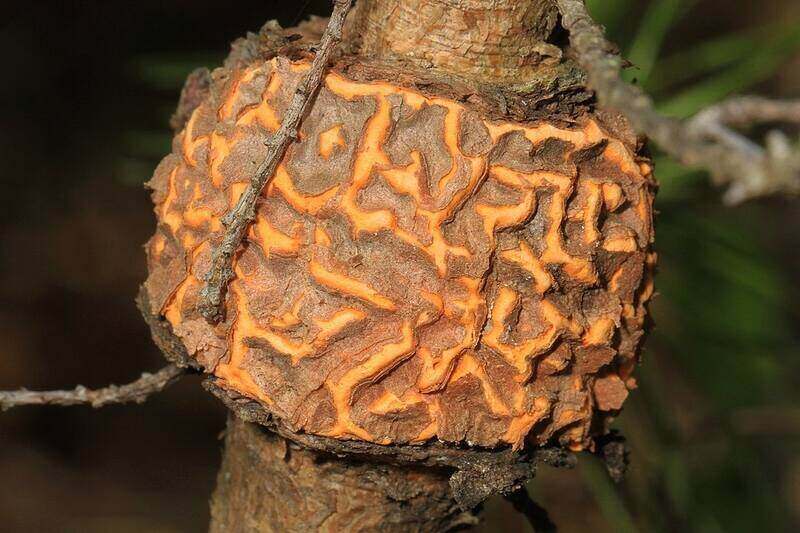
Photo Credit: Judy Gallagher / Wikimedia Commons / CC BY 4.0
Fusiform rust is a fungal disease (Cronartium quercuum) that requires two hosts to complete its reproductive stages. This is why this pine fungus also manifests as a disease in oak trees. Early rapid tree growth, warm and moist conditions, and the alternate host’s presence increase the possibility of infection. Fusiform rust is a severe disease affecting seedlings in nurseries and fields in the southern United States.
Pine trees affected: Slash and loblolly pine are common hosts of this disease. Longleaf is moderately resistant.
Symptoms: The development of galls, spherical or linear swellings, on branches, and the trunk are a sign of fusiform rust. Stem breakage at the gall is common. Galls may develop into open cankers, which are sunken, injured, brownish-red lesions.
Causes: The Cronartium quercuum fungus produces five spore stages and requires both an oak and a pine tree to complete its life cycle:
- Pycniospores appear. They are honey-colored droplets that appear on the bark.
- Aeciospores develop a year later and annually after that. They are yellow-orange. They are blown by the wind as far as 300 miles.
- Urediniospores appear as yellow spots on oak leaves. They are often unnoticed. They will be produced throughout the growing season.
- Teliospores are created by the telia, which are hair-like and red-brown. They germinate, protruding three or four basidiospores that are taken by the wind.
- Basidiospores (or sporidia) are carried by the wind to pines to start the disease cycle. They are small, thin-walled, and short-lived.
Treatment: To treat fusiform rust, landowners can remove the galls by pruning or by removing infected trees. Seedling nurseries can control this disease with fungicides.
The Alabama A&M and Auburn Universities Extension advises that landowners who plant seedlings make sure the nursery treats the pine seedlings for fusiform rust. Seedlings infected in the nursery will not survive more than a year or two.
Seasons: The aecia appear on galls in early spring.
Risk level: Young pine seedlings infected with fusiform rust will die a few years after leaving the nursery. Those that survive will grow deformed. Older trees that survive infections may develop a sunken canker. Cankers on stems can make a stem vulnerable to breaking in high wind.
8. Needle Rust
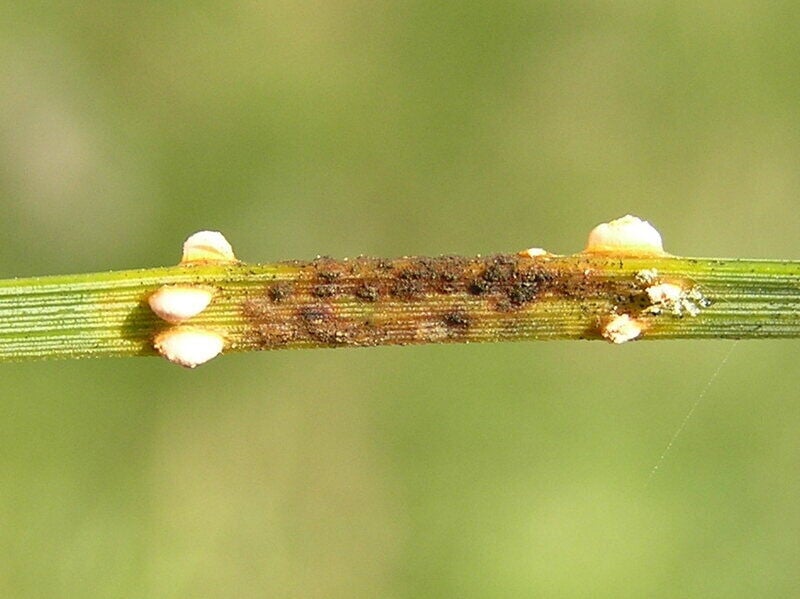
Photo Credit: Beentree / Wikimedia Commons / CC BY 4.0
Needle rust is a seldom-seen disease of pine trees. It needs two different host plants to complete its life cycle — a pine and an aster.
Pine trees affected: Affected pine trees include, but are not limited to:
- Austrian
- Jack
- Red
- Ponderosa
- Mugo
- Scots
Symptoms: In pine trees:
- In spring, yellow-to-orange spots or bands appear on green needles.
- Needles turn yellow.
- In late spring to early summer, tiny, raised, white tubes form on needles.
- Tubes release powdery, orange spores.
- Infected needles may remain attached for several years.
- Severe infection causes needles to die, turn brown, and fall off.
- Lower branches of young trees are most severely affected.
In aster:
- Infected leaves develop yellow leaf spots on the upper leaf surface.
- Raised orange spore-filled pustules form on the lower leaf surface.
- In summer, powdery, yellow-orange spores are produced on the lower leaf surface.
- In late summer and fall, dark brown spores appear within leaf spots on the lower leaf surface.
Causes: The fungus Coleosporium asterum causes needle rust. As happens with many rust fungi, C. asterum needs two different host plants, in this case, a pine tree and an aster.
Treatment:
- Live with the disease. Pine needle rusts do very little damage.
- Water and mulch. Do this when it is dry to help infected trees.
- Remove the asters. Pine needle rust needs both pine needles and asters to complete its life cycle. Separating the asters from the pines can break the cycle.
- Plant resistant species. Replace susceptible pines with white pines, which are resistant, or switch to, say, Colorado or Norway spruce, which are not pines but are resistant.
Seasons: Needle rust’s life cycle begins in the fall when pine needles are first infected. By early spring, the aecia have produced spores to infect adjacent aster leaves. Once fall arrives, the spores developed in aster leaves are released to reinfect the pine needles.
Risk level: Rust causes minor needle cast and discoloration of needles. Even the severe cases rarely kill trees.
9. Pine Wilt
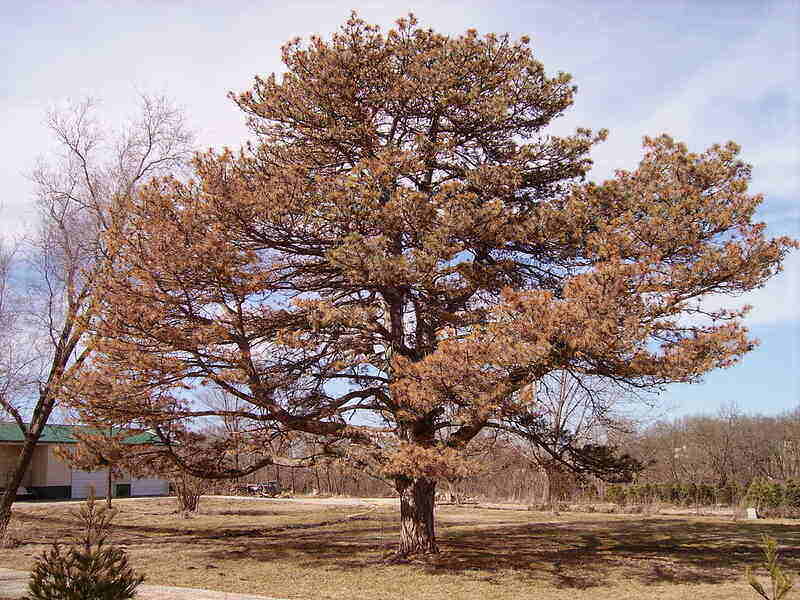
Photo Credit: Mateinsixtynine / Wikimedia Commons / CC BY-SA 3.0
Pine wilt is a lethal disease caused by the pine wilt nematode Bursaphelenchus xylophilus. The pine sawyer beetle carries the nematode to its host. The nematode requires high summer temperatures to develop in the beetle and within the tree.
Pine trees affected: Exotic pines are susceptible to infection:
- Scots
- Austrian
- Mugo
- Japanese red
- Eastern white
Symptoms: The needles are the first part of the tree to show signs of pine wilt. They turn a grayish-green, and then a yellow and reddish-brown. The tree will die within a few weeks or months after turning this color.
Causes: Pine sawyer beetles carry pine wilt nematodes from diseased trees to healthy trees, transferring them as they feed. The nematodes can also infect the host when the beetle lays eggs. The nematodes then multiply within the tree and block the pine’s water transport system.
Treatment: Landowners must remove the infected pine tree immediately. Chip, burn, or bury the diseased wood before the emergence of pine sawyer beetles in late June. Do not save any infested timber for firewood or transportation.
The Colorado State University Extension finds two nematicidal avermectin compounds that treat pine wilt, but these are directed at nematodes, not the pine sawyer beetle, and require a professional arborist to inject. Also, the procedure is not useful if the nematodes have already colonized the tree or if it is already showing symptoms.
Seasons: Most pine wilt deaths occur in late summer or fall.
Risk level: If landowners have not executed prevention methods, pine wilt will kill infested trees. There is no treatment to kill the pine sawyer beetle. Once the nematodes have infected the pine tree, treatment is too late. But take action to prevent further infestation in adjacent trees.
10. Pitch Canker
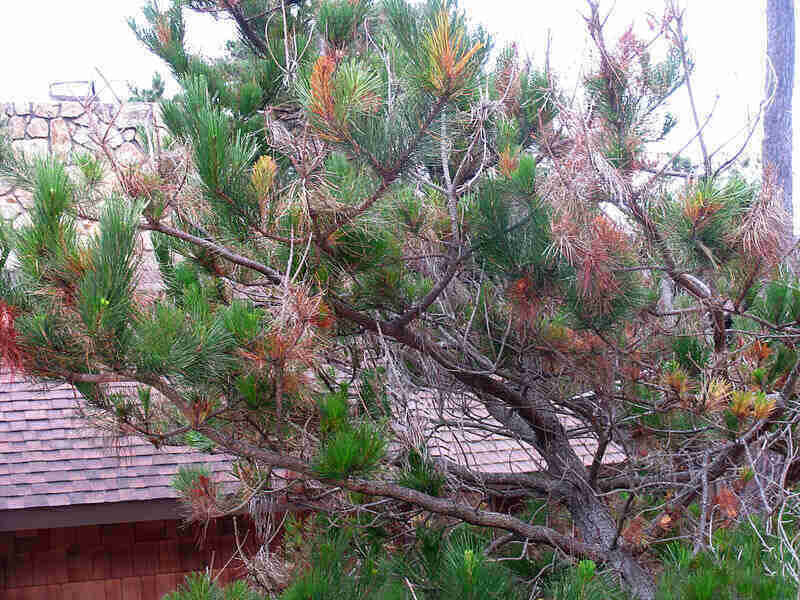
Photo Credit: Joseph O’Brien, USDA Forest Service, Bugwood.org / Wikimedia Commons / CC BY 3.0 US
Pitch canker is caused by the fungus Fusarium circinatum. It occurs in the southeastern United States, Mexico, Chile, Japan, South Korea, Italy, France, Spain, Portugal, and South Africa.
Pine trees affected: Pitch canker affects many pine species:
- Monterey pine, the most widely affected host
- Bishop
- Knobcone
- Gray
- Coulter
- Torrey
- Ponderosa
Symptoms: The fungus causes:
- Infections (lesions) that can encircle branches, exposed roots, and trunks
- Wilt in the tips of branches since water can’t get through
- Needles to turn yellow and then brown, then fall off
- Multiple branch infections
- Dieback in the crown
- The trunk above an encirclement to die
The fungus doesn’t move within the tree, however:
- Each canker or lesion is a separate infection.
- The pitch, also called resin, begins to cluster on the infected site.
- Removal of the bark reveals a honey-colored resin-soaked wood.
- Resin can flow along the bark to coat areas several feet below.
Causes:
- The fungus Fusarium circinatum causes pitch canker.
- Engraver beetles can cause further damage, killing branches, if not the entire pine.
- The resin flow often attracts pitch moths, whose infestation can create a bulging mass of accumulated pitch.
- Insects spread the disease from tree to tree as they feed.
Treatment: The best approach to pitch canker is to prevent the fungus from moving to your healthy trees. If a pine tree is not severely infected, landowners can limit the spread by removing infected branches. It is essential to perform any pruning with sanitized tools.
Insecticides are not an effective way to control pitch canker, and there are no direct methods that control or treat the disease.
Risk level: Pitch canker may result in severe damage or death of your pine tree. Yet individual trees are known to show resistance; cuttings from them can help an infected tree recover. However, trees that are now resistant could become susceptible if the fungus strengthens. You can take action by planting resistant pine trees.
Ask The Experts
Pine Tree Diseases: How to Treat Them
- In your opinion, what curable pine tree disease is the most difficult to treat and why?
- What mistake do homeowners often make when it comes to their pine tree’s health?
- Do you recommend homeowners invest in routine tree health inspections, or is it safe to wait and call an arborist only once there’s a real problem?
- What is your No. 1 tip for keeping a pine tree in good health?


In your opinion, what curable pine tree disease is the most difficult to treat and why?
Actually, all of them. However, if I had to select one, I would think fusiform rust would be the most difficult to treat once observed. Once a tree has fusiform rust, there is little you can do to cure it — you can only manage the problem.
Infected limbs with galls (swellings) can be pruned, but effectively treating infected stems is difficult. Ensuring that a tree is fusiform-rust-free (e.g. planting resistant varieties or nursery-treated individuals) prior to planting is the best method of treatment.
What mistake do homeowners often make when it comes to their pine tree’s health?
Not realizing that there is the possibility for problems, thus failing to periodically inspect their trees. Many landowners forget that trees are living organisms, and thus are susceptible to many damaging agents.
Do you recommend homeowners invest in routine tree health inspections, or is it safe to wait and call an arborist only once there’s a real problem?
Landowners themselves should regularly inspect their pine tree(s). Prevention and the detection of early warning signs is best.
If the landowner notices any discoloration in needles or the loss of needles, it may be best to contact a professional. However, if a landowner notices the presence of insects, discoloration, or some type of exudation from the tree stem or branches, a professional should definitely be contacted to see if treatment is still feasible.
What is your No. 1 tip for keeping a pine tree in good health?
Avoid, as much as possible, damaging the tree such as by removing meaningful amounts of roots, any type of damage to the stem, as well as improper pruning of branches. Even something as seemingly small as “nicking” a tree with lawn equipment can create problems.
FAQ About Pine Tree Diseases
When Should I Worry About My Pine Trees?
The first symptoms of pine tree problems show up on the leaves or branches. When you look at the branches, make it a point to notice discoloration or wilting. If you see such signs, contact a local arborist for a consultation.
Can a Dying Pine Tree Be Saved?
At a certain point, the tree can not be saved. If you see the entire tree changing colors or sap running down, make it a point to act. It is likely too late to save that tree, but you might be able to save other trees and plants around it.
Is a Failing Pine Tree Sure to be Diseased?
Not necessarily, but unless you have a trained eye, it’s hard to diagnose pine tree diseases accurately. It might be something simple: a lack of sunlight, for example. Pine trees need sunshine to thrive; without it, the branches will start dying. Prune them, or neighboring trees, to let in the light.
My Pine Tree Is Losing Needles. Should I Worry?
Older needles (closest to the trunk) will turn brown and fall off, especially as younger needles (on the branch tips) shade them. This is the life cycle of pine trees. However, if the young needles start to fall, you may have an insect or disease attacking the tree. If so, consult a local arborist. If older needles are falling, no action is likely needed.
When to Call a Professional
Consulting a professional, licensed arborist near you is an essential first step to saving your pine tree. If you notice any symptoms in your pine tree, call a tree care professional right away.
A certified arborist can apply treatments and remove infected trees. Arborists can even assist homeowners before symptoms occur by performing preventive disease measures. When pine tree diseases go ignored, they may become fatal and infest adjacent pines.
Main Photo Credit: jacilluch / Wikimedia Commons / CC BY-SA 2.0